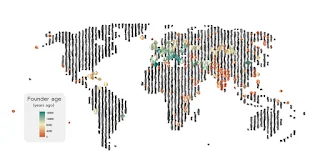While to most children, COVID-19 is a relatively mild illness, a significant number become ill enough to be admitted to hospital. According to an international study led by Dr Anna Funk, PhD, an epidemiologist and University of Calgary postdoctoral fellow, of those who were hospitalised for 48 hours or more, had 4 or more symptoms at the initial Emergency Department (ED) assessment and were aged 14 years or older, 60% went on to develop 'Long Covid' and show symptoms 90 days later.
The results of the study were published yesterday in the open access Journal of the American Medical Association (JAMA Network Open).
According to UCalgary News:
The study included 1,884 children with COVID-19 who had 90-day followup. Long COVID was found in nearly 10 per cent of hospitalized children and five per cent in children discharged from the ED.We found that in some children, illness with COVID-19 is associated with reporting persistent symptoms after three months.
Our results suggest that appropriate guidance and followup are needed, especially for children at high risk for long COVID.
Dr. Stephen Freedman, MD, principal investigator
Paediatric emergency medicine physician
Alberta Health Services
And associate professor of medicine
Cumming School of Medicine (CSM).
Reported rates of long COVID in adults are substantially higher than what we found in children.
Our findings can inform public health policy decision regarding COVID-19 mitigation strategies for children and screening approaches for long COVID among those with severe outcomes.
Dr. Nathan Kuppermann, MD, MPH, co-principal investigator
University of California
Davis School of Medicine, Sacramento.The most-reported persistent symptoms in children were fatigue or weakness, cough, difficulty breathing or shortness of breath.Our finding that children who had multiple COVID-19 symptoms initially were at higher risk for long COVID is consistent with studies in adults.
Unfortunately, there are no known therapies for long COVID in children and more research is needed in this area. However, if symptoms are significant, treatment targeting the symptoms is most important. Multidisciplinary care is warranted if symptoms are impacting quality of life.
Dr. Todd Florin, MD, MSCE, co-principal investigator
Ann & Robert H. Lurie Children’s Hospital
Chicago and Northwestern University Feinberg School of Medicine.
Key PointsThe irony is it is more or less the same antivaxxer covidiots who were jubilant when SCOTUS effectively took away the right of American women to plan their parenthood on the grounds that they were 'pro-life', who are campaigning to persuade people to risk their children's lives and welfare by not getting vaccinated against COVID-19. Clearly, these people don't really believe in the sanctity of life; what they believe in is imposing their will on other people. Religion merely provides them with the excuse they need.
Question What proportion of children infected with SARS-CoV-2 who were tested in emergency departments (EDs) reported post–COVID-19 conditions (PCCs) 90 days after their ED visits?
Findings In this cohort study of 1884 SARS-CoV-2–positive children with 90-day follow-up, 5.8% of patients, including 9.8% of hospitalized children and 4.6% of discharged children, reported PCCs. Characteristics associated with PCCs included being hospitalized 48 hours or more, having 4 or more symptoms reported at the index ED visit, and being 14 years of age or older.
Meaning This study suggests that, given the prevalence of PCCs, appropriate guidance and follow-up are required for children testing positive for SARS-CoV-2.
Abstract
Importance Little is known about the risk factors for, and the risk of, developing post–COVID-19 conditions (PCCs) among children.
Objectives To estimate the proportion of SARS-CoV-2–positive children with PCCs 90 days after a positive test result, to compare this proportion with SARS-CoV-2–negative children, and to assess factors associated with PCCs.
Design, Setting, and Participants This prospective cohort study, conducted in 36 emergency departments (EDs) in 8 countries between March 7, 2020, and January 20, 2021, included 1884 SARS-CoV-2–positive children who completed 90-day follow-up; 1686 of these children were frequency matched by hospitalization status, country, and recruitment date with 1701 SARS-CoV-2–negative controls.
Exposure SARS-CoV-2 detected via nucleic acid testing.
Main Outcomes and Measures Post–COVID-19 conditions, defined as any persistent, new, or recurrent health problems reported in the 90-day follow-up survey.
Results Of 8642 enrolled children, 2368 (27.4%) were SARS-CoV-2 positive, among whom 2365 (99.9%) had index ED visit disposition data available; among the 1884 children (79.7%) who completed follow-up, the median age was 3 years (IQR, 0-10 years) and 994 (52.8%) were boys. A total of 110 SARS-CoV-2–positive children (5.8%; 95% CI, 4.8%-7.0%) reported PCCs, including 44 of 447 children (9.8%; 95% CI, 7.4%-13.0%) hospitalized during the acute illness and 66 of 1437 children (4.6%; 95% CI, 3.6%-5.8%) not hospitalized during the acute illness (difference, 5.3%; 95% CI, 2.5%-8.5%). Among SARS-CoV-2–positive children, the most common symptom was fatigue or weakness (21 [1.1%]). Characteristics associated with reporting at least 1 PCC at 90 days included being hospitalized 48 hours or more compared with no hospitalization (adjusted odds ratio [aOR], 2.67 [95% CI, 1.63-4.38]); having 4 or more symptoms reported at the index ED visit compared with 1 to 3 symptoms (4-6 symptoms: aOR, 2.35 [95% CI, 1.28-4.31]; ≥7 symptoms: aOR, 4.59 [95% CI, 2.50-8.44]); and being 14 years of age or older compared with younger than 1 year (aOR, 2.67 [95% CI, 1.43-4.99]). SARS-CoV-2–positive children were more likely to report PCCs at 90 days compared with those who tested negative, both among those who were not hospitalized (55 of 1295 [4.2%; 95% CI, 3.2%-5.5%] vs 35 of 1321 [2.7%; 95% CI, 1.9%-3.7%]; difference, 1.6% [95% CI, 0.2%-3.0%]) and those who were hospitalized (40 of 391 [10.2%; 95% CI, 7.4%-13.7%] vs 19 of 380 [5.0%; 95% CI, 3.0%-7.7%]; difference, 5.2% [95% CI, 1.5%-9.1%]). In addition, SARS-CoV-2 positivity was associated with reporting PCCs 90 days after the index ED visit (aOR, 1.63 [95% CI, 1.14-2.35]), specifically systemic health problems (eg, fatigue, weakness, fever; aOR, 2.44 [95% CI, 1.19-5.00]).
Conclusions and Relevance In this cohort study, SARS-CoV-2 infection was associated with reporting PCCs at 90 days in children. Guidance and follow-up are particularly necessary for hospitalized children who have numerous acute symptoms and are older.
Funk AL, Kuppermann N, Florin TA, et al.
Post–COVID-19 Conditions Among Children 90 Days After SARS-CoV-2 Infection.
JAMA Netw Open. 2022; 5(7): e2223253. doi: 10.1001/jamanetworkopen.2022.23253
Copyright: © 2022 The authors.
Published by American Medical Association. Open access
Reprinted under a Creative Commons Attribution 4.0 International license (CC BY 4.0)
Although the figures above are statistically interesting, I would suggest the only one that should interest responsible, loving parents is the one that shows your children run a significant risk of contracting 'Long COVID' if they become infected. Other studies have shown that all the vaccines are effective at reducing the risk of a serious breakthrough infection, so there really is no valid argument:
















































